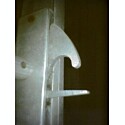Ladder
From Wikipedia, the free encyclopedia
A ladder is a vertical or inclined set of rungs or steps. There are two types: rigid ladders that can be leaned against a vertical surface such as a wall, and rope ladders that are hung from the top. The vertical members of a rigid ladder are called beams (US) or stiles (UK). With a bit of agility, one can slide down the stiles without climbing down each rung. Rigid ladders are usually portable, but some types are permanently fixed to buildings.
Contents |
[edit] Variations
Rigid ladders are available in many forms, such as:
- Fixed ladder, two stiles joined by several rungs; no moving parts
- Extension ladder, fixed ladder divided into two or more lengths for more convenient storage; the lengths can be slid together for storage or slid apart to maximize the length of the ladder; a pulley system may be fitted so that the ladder can be easily extended by an operator on the ground then locked in place using the dogs and pawls
- Step ladder, hinged in the middle to form an inverted V, with stays to keep the two halves at a fixed angle
- Platform steps, step ladder with small horizontal platform at the top
- Telescopic ladder, stiles consist of short lengths of concentric tubing that can be slid inside each other for storage
- Roof ladder, rigid ladder with large hook at the top to grip the ridge of a pitched roof
- Cat ladder, lightweight ladder frame used on steep roofs to prevents workers from sliding
- Hook ladder or pompier ladder, rigid ladder with a hook at the top to grip a windowsill; used by firefighters
- Turntable ladder, extension ladder fitted to rotating platform on top of a fire truck
Rigid ladders were originally made of wood, but in the 20th century tubular aluminum became more common because of its lighter weight. Ladders with fiberglass stiles are used for working on or near overhead electrical wires, because fiberglass is an electrical insulator.
For safety, a rigid ladder should be leaned at an angle of about fifteen degrees to the vertical. In other words, the distance from the foot of the ladder to the wall should be about one quarter of the height of the top of the ladder. At steeper angles, the ladder is at risk of toppling backwards when the climber leans away from it. At shallower angles, the ladder may lose its grip on the ground. Ladder stabilizers are available that increase the ladder's grip on the ground.
A ladder standoff, or stay, is a device fitted to the top of a ladder to hold it away from the wall. This enables the ladder to clear overhanging obstacles, such as the eaves of a roof, and increases the safe working height for a given length of ladder.
- Rope ladders are used where storage space is extremely limited, weight must be kept to a minimum, or in instances where the object to be climbed is too curved to use a rigid ladder. They may have rigid or flexible rungs. Climbing a rope ladder requires more skill than climbing a rigid ladder, because the ladder tends to swing like a pendulum.
- Dissipative ladders are portable ladders built to ESD (Electrostatic Discharge) standard. Electrostatic Discharge is a natural occurrence in which electricity is passed through our body, or other conductor, and discharges onto some object. For example, the shock we feel when we touch a doorknob is an ESD. This natural occurrence is becoming a very hot topic in the field of electronics assembly due to the costly damage ESDs can cause to sensitive electronic equipment. Dissipative ladders are ladders with controlled electric resistance: the resistance slows the transfer of charge from one point to another, offering increased protection during ESD events: ≥105 and < 1012 Ω / square ([e.g.][1])
- Pool ladders. A ladder is also used on the side of a boat, to climb into it from the water, and in a swimming pool. Swimming pool ladders are usually made from plastic steps with special grip and metal bars on the sides to support the steps and as handrails for the user.
[edit] Historical usage
Ladders are ancient tools and technology. A ladder is depicted in a Mesolithic rock painting that is at least 10,000 years old, depicted in a cave in Valencia, Spain. Bee Wilson (2004: p.5) references the rock painting which shows two naked humans carrying baskets or bags that are employing a long wobbly ladder, which appears to be made out of some kind of grass, to reach a wild honeybee nest to harvest honey. Modern ladders are believed to have been conceived by Hebrews and Egyptians.
[edit] See also
[edit] References
| This article needs additional citations for verification. Please help improve this article by adding reliable references. Unsourced material may be challenged and removed. (May 2007) |
- Wilson, Bee (2004). The Hive: The Story Of The Honeybee. London, Great Britain: John Murray (Publishers). ISBN 0 7195 6598 7
[edit] External links
- Ladder Usage Safety and handling ladders
- Ladder Literature from Werner Co.: technical manuals, comparison charts, and safety sheets.
- Ladder Safe Work Procedures
- Ladder safety manuals





